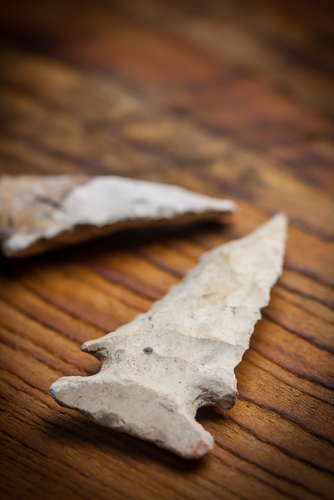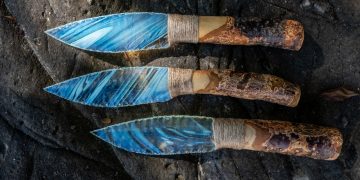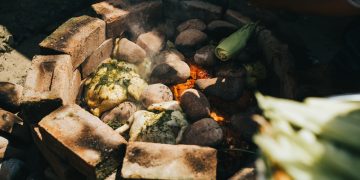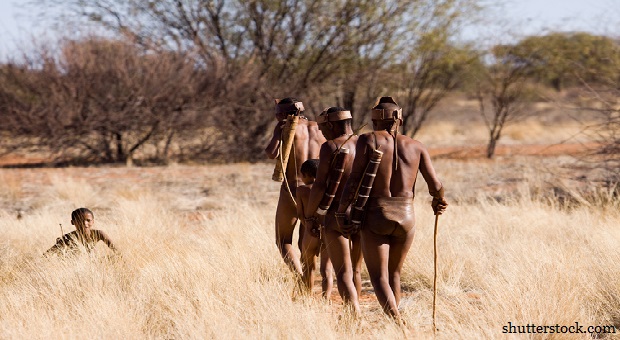Mankind has hunted all through history, killing animals for food. The earliest people were hunter-gatherers, who combined their hunting with gathering edible plants, fruits, nuts and roots. Gradually, over time, these methods were replaced by agriculture, as growing plants and animals for food is much more efficient than harvesting them out of nature.
From the American Indians to the Aboriginees of Australia; from tribes in the vastness of Africa to those living in the Amazon jungle, some of the greatest hunters of all time kept their families fed by harvesting from the animal kingdom all around them.
Some small pockets of these ancient civilization still exist. While much of the world has moved on to modern methods, these people hold onto the ways of their ancestors.
These are not modern hunters, with guns, but native tribes who still hunt in the manner of their ancestors, using the same weapons and techniques to find their food. While there number is small, we can still learn much of our own past, by looking at these primitive people and the manners which they use to hunt for food.
While it might seem that our modern methods are much more efficient than those of these tribes, the very fact that they have managed to sustain themselves through the millennia is proof enough of the effectiveness of their methods. Should the world ever be faced by a global catastrophe, those methods may be the very ones we need to use, in order to keep ourselves alive.
It is worth learning the method of these ancient people, as they are true survivalists. While their methods may not be elegant, they are effective. When all is said and done, that’s really all that matters.
Weapons of these Primitive Hunters
Anthropologists have hypothesized that the earliest hunting tools that mankind developed were done to copy what nature gave to the animals. Natural predators like wolves, tigers and bears had long claws and sharp teeth; neither of which mankind possessed. But mankind had something that the lions and tigers and bears didn’t have, the ability to reason. So he invented his own claws.
The points of spears, knives and even arrows are simply copies of what nature has given to animals. The idea of attaching those knives to wood shafts, turning them into spears, came from a need to be able to reach farther. Even three-pointed spears, used for fishing, are a copy of what nature gave to animals, effectively functioning much as a bird’s claw to stab and grab fish in the water.
While it is unknown how the bow was invented, the idea can be seen to come from nature as well. Some sorts of birds fish by diving into the water and spearing the fish with their long beaks. The arrow is nothing more than a copy of the bird, with the bow giving it the velocity to fly.

© shutterstock.com
Another tool for hunting that comes from birds is the net. The pelican is perhaps one of the most unique birds in the world, with its large, pouched beak, which forms a natural net. The pelican is therefore able to fly close to the water, with the lower part of his beak passing through the water like a net, and scoop up fish for dinner.
As time went on, weapons development moved from copying nature to seeking ways of improving upon what nature has given to the animals. Better bows, better spears, the atlatl, a stick for throwing spears, probably came about from observing that a man with longer arms can throw with more force than a boy with short ones.
It stands to reason then, that an even longer arm would work better, so the atlatl was created to artificially extend the arm.
Bows and Blowguns
It is interesting to note that both blowguns and bows have survived as hunting weapons throughout the centuries. The bow may very well be the oldest weapon in existence, which is still in constant use. While there have been many different designs of the bow throughout history, the basic weapon is largely unchanged.
In a survival situation, the bow could very well be a much more effective weapon for hunting than the gun. A combination of the ability to make one’s own ammunition and the ability to hunt silently are critical, as the sound of a gun can be heard from a long ways away, possibly attracting unwanted visitors who may try to take your kill away from you by force.
Another thing that many of these native tribes have taken from nature is the use of poisons. Many different types of animals use poisons for hunting, paralyzing their prey so that they can eat them. Primitive tribes that use poisons for hunting usually milk the poisons from these animals, such as milking the poison from snakes, so that they can put it on their arrows.
Persistence Hunting
In the Kalahari Desert of southern Africa, Kalahari bushmen use a method known as persistence hunting, literally running their prey down over a period of two to five hours. Their weapons are simple and crude, but it is not their weapons that allow them to hunt so effectively, it is that they use their bodies as their prime weapon.
Although not widely known, a man in good shape can run most animals into the ground. I’m referring here to animals who are accustomed to running, such as the kudu of Africa, a type of antelope. While these animals are great runners, their stamina is limited. They have to stop and rest, as well as drink water to cool their bodies from the exertion of running.
Men are able to run farther than animals because of a combination of factors. First of all, it takes less energy for a two-legged man to move through the grass than it takes for a four-legged animal. So, the man can go farther without eating than the animal can.
But the bigger reason, especially in Africa, is that humans perspire, which provides for natural cooling. Many of the animals which are hunted through persistence hunting don’t perspire or perspire very little, so they are forced to stop and drink cool water to cool their bodies.
The bushmen chase the animals until they reach a point where they are forced to stop and rest. At that point, they are able to get close enough to the animals that they can kill them with their spears. The patience and endurance of the hunters pays off in making their kill.
Hunting in Groups
Many native tribes hunt in small groups, like the Bariba tribe of Africa. Although for major hunts, it was not uncommon for a number of groups to gather together and work in harmony on the hunt. Working together increases their chances of success, as multiple hunters can shoot at the same animal, increasing their chances of a fatal hit.
With the Bariba, as well as some other primitive tribe, boys and younger men are allowed to shoot first, with the older hunters backing them up. That way, the more experienced hunters, who are also better shots, ensure that the hunt is successful, while giving their younger charges a chance to practice.
Video First Seen On: Planet Doc Full Documentaries
We’ve all seen pictures of cavemen hunting mammoths and mastodons, with a number of different hunters striking the animal with their spears. Working together against a larger animal increases the chance of success, by increasing the amount of injury they are able to inflict upon the animal. One man alone probably can’t kill that large a beast, but several working together can.
Another reason that these tribes hunt in groups is to surround an area and drive the game out of the bush. This is especially useful in areas where game is scarce and doesn’t come out in the open where it is visible. With one group acting as beaters, they can drive the game towards others, who are waiting to make the kill.
We see groups hunting together in many other cultures as well. One of the techniques that the Plains Indians of the Americas used was to drive herds of buffalo off cliffs, where they would fall to their death. Before horses became commonplace in the American West, this was a common method of hunting.
Patience in the Hunt
Another related tribe, the Betamaribe people of Africa, use decoys and lures extensively when hunting. One of Africa’s oldest tribes, these tribes still hunt, even though they plant and raise animals as well. May is the time of the annual hunt, with the various tribes coming together for the major hunt.
These hunts may last for weeks, as the various teams work together, to hunt an area. Often, one hunter will have the lure, which will be either carved from wood to appear like the animals they are hunting or be made from the actual skins of the animals.
This person will find a place to hide, with only the lure showing. Other hunters surround them at a distance, to kill any animals who come, seeking the lure.
This sort of hunting requires great patience, as the hunters have little to disguise them. They count largely on their immobility to keep the animals from seeing them, as the eye is attracted to movement.
By remaining still, they are in range when the animals reach the lure.
The Comanche Indians and the Horse
The American Indians were great hunters, as this was their main source of food. Before 1625, the Comanches were one of the smaller and weaker of the Indian tribes. They were hunter-gatherers with a remarkably simple culture, unlike the more complex builder cultures of the Mayans and Aztecs found in Mesoamerica.
But starting in 1625, the Comanche tribe underwent an incredible transformation. They were the first of the American Indian tribes to recognize and adapt the power of the horse. This caused them to rise to become one of the dominant powers in America.
Horses had been brought to the New World by the Spaniards. Adapting readily to the environment and the abundance of food, horses bred and spread rapidly. The Comanches immediately understood the value of the horse, breaking, breeding and riding them, both in the hunt and in war.
Hunting from the backs of horses, Comanche warriors were able to hunt the buffalo much more effectively, even when the herd would stampede.
The use of the horse made the Comanche tribe the most powerful tribe on the plains, taking over territory and hunting grounds previously held by other tribes. Their wealth grew, as the horse allowed them to hunt better, following the herds and approaching them more easily.
It even made it possible for the Comanche to stop the westward expansion of settlers in Texas; a stop they were able to enforce for 40 years.
Waste Not
Indigenous hunters of all types make use of all parts of the animal, whether for food, clothing, containers or making additional weapons. The sinew of a shoulder muscle can be rolled to form bowstrings. Organs like the gall bladder can be dried and treated to be made into containers.
Bones can be used for chipping arrowheads, and of course, the skins of animals can be dried and tanned, turning them into leather for clothing, footwear and even shelters.

© shutterstock.com
All indigenous tribes live largely attuned to nature, as if they are part of nature itself. This affinity for nature shows in their desire to waste none of what they catch, utilizing every part of an animal they can. They respect the animals they kill, even to the point of thanking them and praying for their spirits after killing them.
Compared to this, the trophy hunters of the western world are incredibly wasteful, killing animals just for the horns, tusks and hides; often leaving the meat to rot. Yet the flesh of many kinds of animals is edible, not just of those animals we are accustomed to eating. In the Old West, it was said that cougar meat (mountain lion) was some of the best meat there was.
If a rancher had to kill a cougar that was bothering his herds, you could be sure that the cougar would end up being served at the table.

























































































Thank You, Bill. Some VERY Interesting Commentary and Information here. I really learned some things. Appreciate your Efforts.
Modern hunters do not waste game meat. Wasting game meat is unethical and illegal. In every state in the United States, game laws prohibit the waste of game meat Propagating the notion that modern hunters are wasteful is inaccurate, and feeds a notion to non-hunters that is not true.
No the author is correct Mr. Taylor he said trophy hunters. Now us good ol boys who grew up as hubti8as a way of life may not waste meat. The city slicking trophy hunting douchebags do waste meat. Most just desire a head on their wall which is ignorant. Even the country folks who eat the meat and still display a head is stupid. I’ve shot a hundred deer and not one head on any wall. True hunters respect their prey and don’t desire to show off to others what they have killed. Hunting for sport is WRONG period. Where I’m from we literally hunt to put meat in the freezer and feed our families.
Hey there
I’m waiting for the Hunting Crossbow I Order with you.
Can anyone tell me what’s going on with it? When will i get that??
Thank you
Hello, Zipi. Our team will contact you through email as soon as possible 🙂 Thanks a lot!